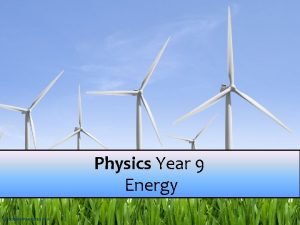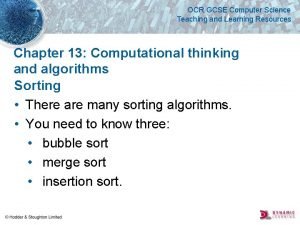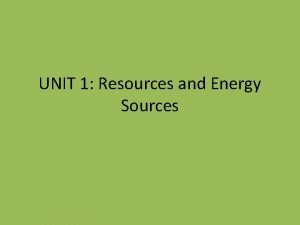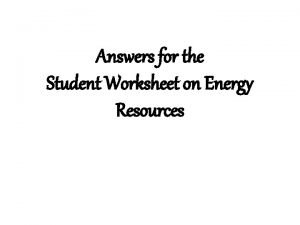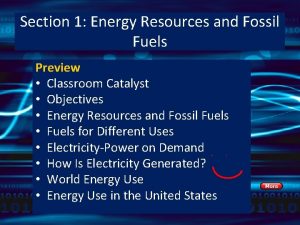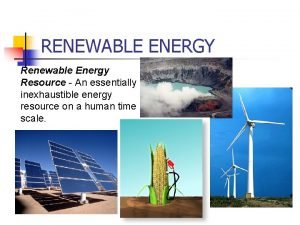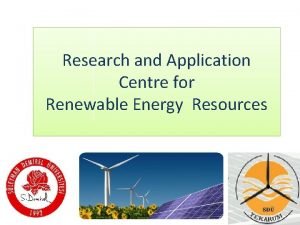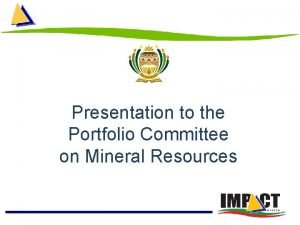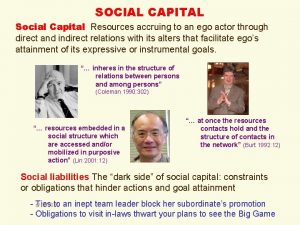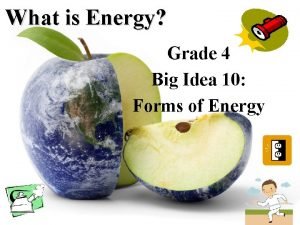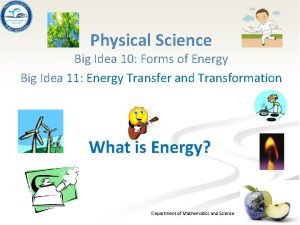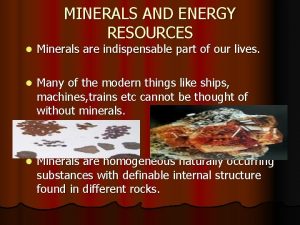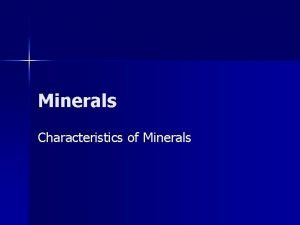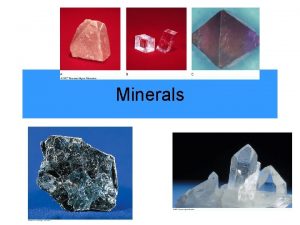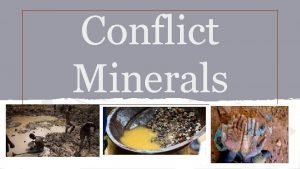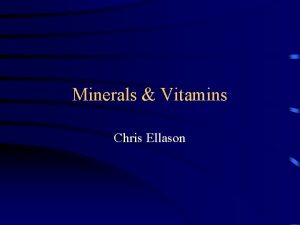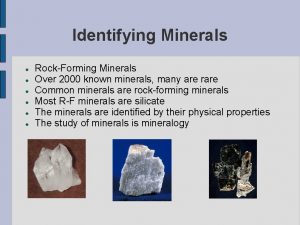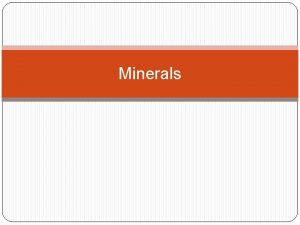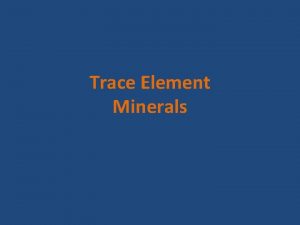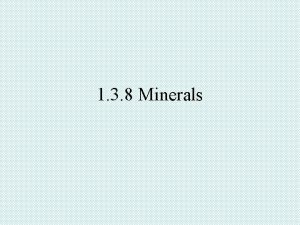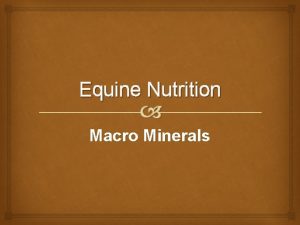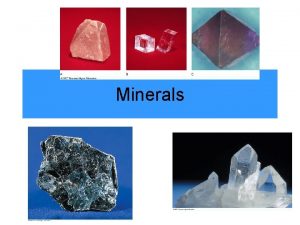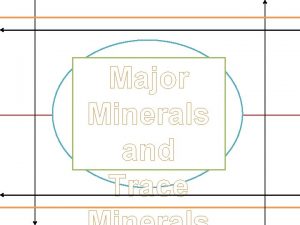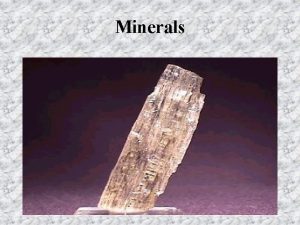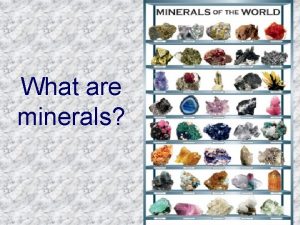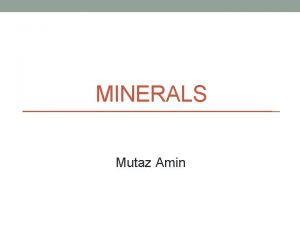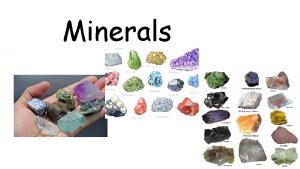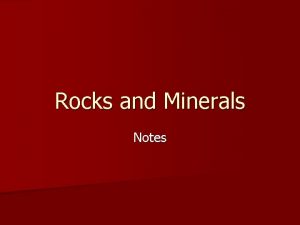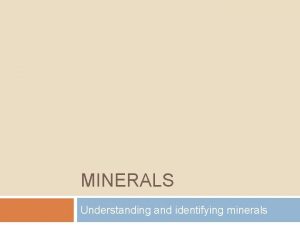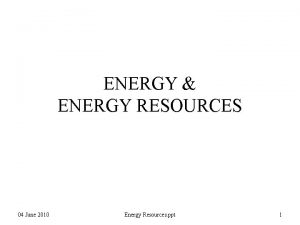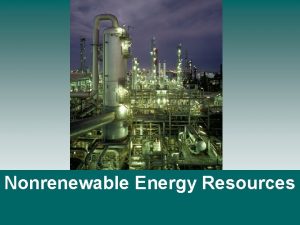SOCIAL SCIENCE EEEEEEEEEEEEEEEEEEEEEEEEEEEEEEEEEEEEEEEEEEEEEEEEEE Minerals energy resources MINERALS q































- Slides: 31

SOCIAL SCIENCE EEEEEEEEEEEEEEEEEEEEEEEEEEEEEEEEEEEEEEEEEEEEEEEEEE

Minerals & energy resources

MINERALS q. Minerals are an indispensable part of our lives. q. Tiny pen to a towering building or a big ship , railway lines & the tarmac [paving] of the roads , our implements & machinery , the food we eat too are made from MINERALS.

What is a MINERAL ? Geologists define mineral as a “homogenous , naturally Occurring substance with a definable internal structure. ” Rocks are combinations of homogenous substances called MINERALS. A particular mineral that will be formed from a certain combination of elements depends upon the physical & chemical conditions under which the material forms. This , in turn , results in a wide range colors , hardness & crystal forms , luster& density that a particular mineral possesses. Geologists use these properties classify the minerals.

CLASSIFICATION OF MINERALS

Metallic : FERROUS MINERALS • Ferrous minerals account for about three-fourth of the total value of the production of minerals. • They provide a strong base for the development of metallurgical industries. • India exports substantial quantities of ferrous minerals after meeting her internal demands.

IRON ORE • Iron ore is he basic mineral & the backbone of industrial development. • India is endowed with fairly abundant resources of iron ore. • India is rich in good quantity of iron ore. • MAGNITITE is the finest iron ore with a very high content of iron up to 70 per cent. • It has excellent magnetic qualities , especially valuable in the electrical industry.

• Hematite ore is the most important electrical industrial iron ore in terms of the quantity used , but has a slightly lower content than magnetite. [50 -60].


MAGANESE o Manganese is mainly used in the manufacturing of steel & Ferro- manganese alloy. o Nearly 10 kg of manganese is required to manufacture one tone of steel. o It is also used in manufacturing bleaching powder , insecticides & paints. o ORISSA is the largest producer of manganese ores in India. o It accounted for one – third of the country’s total production in 2000 -01.


NON-FERROUS MINERALS ØIndia’s reserves & production of Nonferrous minerals is not very satisfactory. ØHowever ‘ these minerals , which include copper , bauxite , lead , zinc & gold play a vital role in a number of metallurgical , engineering & electrical industries.

DISTRUBUTION OF COPPER BAUXITE & COPPER ØIndia is critically deficient in the reserve & production of copper. ØBeing malleable , ductile & a good conductor , copper is mainly used in a electrical cables , electronics & chemical industries. ØThe Blight mines in M. P produce 52 per cent of India’s copper. ØThe Sing hum district of Jharkhand is also a leading producer of copper. ØThe Cheri mines in Rajasthan are also famous.


BAUXITE • Several Ores contain aluminum , it is from bauxite , a clay – like substance that alumina & later aluminum is obtained. • Bauxite deposits are formed by the decomposition of a wide variety of rocks rich in aluminum silicates. • India’s bauxite deposits are mainly found in the Amarkantak plateau , Baikal hills & the plateau region of Ballarpur – Kati. • Orissa is the largest bauxite producing state in India with 45 per cent of the country’s total production in 2000 – 01. • Panchpatmali deposits in Karafuto district are the most important bauxite deposits in the state.


Non-metallic minerals MICA v. Mica is a mineral made up of a series of plates or leaves. v. It splits easily into thin sheets. v. Mica can be clear , black , green , red yellow or brown. v. Due to its excellent di – electric strength , low power loss factor , insulating properties & resistance to high voltage , mica is one of the most indispensable minerals used in electric & electronic industries. v. Mica deposits are found in the northern edge of the Chota Nagpur plateau. v. In Rajasthan , the major mica producing area is around Ajmer. v. Nellore mica belt of Andhra Pradesh is also en important producer in the country.

ROCK MINERALS LIME STONE It is found in association with rocks composed of calcium carbonates or calcium & magnesium carbonates. It is found in sedimentary rocks of most geological formations. Limestone is the basic raw material for the cement industry & essential for smelting iron ore in the blast furnace.

HAZARD OF MINING Stricter safety regulations & implementation of environmental laws are essential to prevent mining from becoming a “ Killer industry ”

CONSERVATION OF MINERALS Ø The total volume of workable mineral deposits is an insignificant fraction i. e. one per cent of the earth crust. Ø We rapidly consuming mineral resources that required millions of years to be created & concentrated. Ø The geological processes of mineral formation are so slow that the rates of replenishment are infinitely small in comparison to he present rates of consumption. Ø Minerals resources are , therefore , finite & non-renewable. Ø Rich mineral deposits are our country’s extremely valuable but short-lived possessions. Ø Continued extraction of ores leads to increasing costs as mineral extraction comes from greater depths along with decrease in quantity.

ØA concerted effort has to be made in order o use our mineral resources in a planned &sustainable manner. ØImproved technologies need to be constantly evolved to allow use of low grade ores at low costs. ØRecycling of metals , using scraps metals & other substitutes are steps in conserving our mineral resources fir the future.

Energy resources ØEnergy is required for all activities. ØIt is needed to provide light & heat , to propel vehicles , to cook & to drive machinery in industries. ØEnergy can be generated from fuel minerals like coal , petroleum , natural gas , uranium & from electricity.

Energy resources can be classified as : CONVENTIONAL SOURCES NON-CONVENTIONAL SOURCES v They include : firewood , cattle dung cake , coal , petroleum , natural gas & electricity [ both hydel & thermal] v Firewood 7 cattle dung cake are most common in rural India. v According to one estimate more than 70 per cent energy requirement in rural households is met by these two ; continuation of these is increasing forest area. v Moreover , using dung cake too is being discouraged because it consumes most valuable manure which could be used in v They include : solar, wind tidal , geothermal , biogas & atomic energy. v The growing consumption of energy has resulted in the country becoming increasingly dependent on fossil fuels such as oil gas 7 coal. v Moreover , increasing use of fossil fuels also causes serious environmental peoblems. v Hence , there is a pressing need to use renewable energy sources like solar energy , wind tide , biomass 7 energy from wast maerial. These are called Non -

Conventional sources of energy Ø Coal : In India , Coal is the most abundantly available fossil fuel. Ø It provides a substantial part of the nation’s energy needs. Ø It is used for power generation , to supply energy to industry as well as for domestic needs. Ø India is highly dependant on coal for meeting its commercial energy requirements. Ø Coal is formed due the compression of plant material over millions of years. Ø Coal is found in a variety of forms depending on the degrees of compression 7 the depth 7 time of burial. Ø LIGNITE is a low grade brown coal , which is soft with high moisture content. Ø BITUMINOUS coal is the most popular coal in commercial use. Ø In India coal occurs in rocks series of two main geological ages , namely GONDWANA & TERTIARY DEPOSITS. Ø ANTHRACITE is the highest quality hard coal.

petroleum ØPetroleum or mineral oil is the ext major energy sources in India after coal. ØIt provides fuel for heat & lighting , lubricants for machinery & raw materials for a number of manufacturing industries. ØPetroleum refineries act as a “ nodal industry “ for synthetic textile , fertilizer & numerous chemical industries. ØAbout 63 per cent of India’s petroleum production is from Mumbai high , 18 per cent from Gujarat & 16 per cent from Assam.

Natural gas ØNatural gas is an important clean energy resource found in association with or without petroleum. ØIt is used as a source of energy as well as an industrial raw material in the petrochemical industry. ØLarge reserves of natural gas have been discovered in the Krishna – Godavari basin. ØNatural gas is considered an environment friendly fuel because of low carbon dioxide emissions 7 is , therefore , the fuel for the present century.

electricity ØElectricity has such a wide range of application in today’s world that , its percapita consumption is considered as an index of development. ØElectricity is generated mainly in two ways : by running water which drives Hydro turbines to generate Hydro electricity ; & by burning other fuels such s coal petroleum 7 natural gas to drive turbines to produce Thermal power.

HYDRO ELECTRICITY Ø It is generated by fast flowing water , which is a renewable resource. Ø India has a number of multi – purpose projects like the Bhakra Nangal , Damodar Valley corporation , the Kopili Hydel Project etc. producing hydroelectric power. THERMAL ELECTRICITY Ø It is generated by using coal , petroleum 7 natural gas. Ø Thermal power stations use non-renewable fossil fuels for generating electricity. Ø There are over 310 thermal power plants in India.

NON – CONVENTIONAL SOURCES OF ENERGY Ø NULEAR OR ATOMIC ENERGY : It is obtained by altering the structure of atoms. The Monazite sands of Kerala is also rich in Thorium. Ø SOLAR ENERGY : India has enormous possibilities of tapping solar energy. It is fast becoming popular in rural & remote areas. The largest solar plant of India is located at Madhapur near Bhuj , where solar energy is used to sterlise milk cans. Ø WIND POWER : The largest wind farm cluster is located in Tamil Nadu from Nagarcoil to Madurai. Ø BOIGAS : Biogas plant are set up at municipal , coorperative & individual levels. The plants using cattle dung are known as “Gobar gas plants ” in rural areas.

Ø It improves the quality of manure & also prevents the loss of trees & manure due to burning of fuel wood & cow dung cakes. Ø TIDAL ENERGY ; Oceanic tides can be used to generated electricity. In India , the Gulf of Kuchchh , provides ideal conditions for utilising tidal energy. A 900 mw tidal energy power plant is set up here by the National Hydropower Corporation. Ø GEO THERMAL ENERGY : It refers to the heat & electricity produced by using the heat from the interior of the Earth. It exists because , the Earth grows progressively hotter with increasing depth. Where the geothermal gradient is high , high temperatures are found at shallow depths. Two experimental projects have been set up in Idia to harness geothermal energy. One is located in the Parvati valley near Manikarn in Himachal Pradesh & the other is located in the Puga Valley , Ladakh.

Conservation of energy resources Ø Energy is a basic requirement for economic development. Every sector of the national economy – agriculture , industry , transport , commercial & domestic – needs inputs of energy. The economic development plans implemented since Independence necessarily required increasing amounts of energy to remain operational. As a result , consumption of energy in all forms has been steadily rising all over the world. Promotion of energy conservation & increased use of renewable energy sources are the twin planks of sustainable energy. Ø India is presently one of the least energy efficient countries in the world. We have to adopt a cautions approach for the judicious use of our limited energy resources. For ex : by using non-conventional sources energy , by using public transport systems instead of individual vehicles , etc …. .
 Eeeeeeeeeeeeeeeeeeeeeeeeeeeeeeeeeeeeeeeeeeeeeeeeee
Eeeeeeeeeeeeeeeeeeeeeeeeeeeeeeeeeeeeeeeeeeeeeeeeee Subject science
Subject science Natural vs social science
Natural vs social science Anthropology vs sociology
Anthropology vs sociology What is the transformation process
What is the transformation process Fixed resources
Fixed resources Renewable resources vs nonrenewable resources
Renewable resources vs nonrenewable resources Energy energy transfer and general energy analysis
Energy energy transfer and general energy analysis Energy energy transfer and general energy analysis
Energy energy transfer and general energy analysis Apa itu social thinking
Apa itu social thinking Social thinking social influence social relations
Social thinking social influence social relations Gzscience
Gzscience Ocr computer science resources
Ocr computer science resources Energy resources definition
Energy resources definition Energy resources student worksheet answers
Energy resources student worksheet answers Energy resources definition
Energy resources definition Fossil fuel deposit
Fossil fuel deposit Chapter 12 nonrenewable energy resources
Chapter 12 nonrenewable energy resources Definition of renewable energy source
Definition of renewable energy source Biomass energy disadvantages
Biomass energy disadvantages Introduction about energy resources
Introduction about energy resources Portfolio committee on mineral resources and energy
Portfolio committee on mineral resources and energy Social capital resources
Social capital resources What are the three branches of science
What are the three branches of science Natural and physical science
Natural and physical science Applied science vs pure science
Applied science vs pure science Science fusion think central
Science fusion think central Tragedy of the commons
Tragedy of the commons Julie lundquist
Julie lundquist Soft science definition
Soft science definition What is energy in science grade 4
What is energy in science grade 4 Different forms of energy
Different forms of energy











